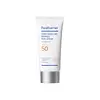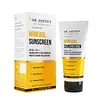What's inside
What's inside
 Key Ingredients
Key Ingredients

 Benefits
Benefits

 Concerns
Concerns

 Ingredients Side-by-side
Ingredients Side-by-side

Water
Skin ConditioningDiisopropyl Sebacate
EmollientButyloctyl Salicylate
Skin ConditioningDibutyl Adipate
EmollientEthylhexyl Triazone
UV AbsorberPolymethylsilsesquioxane
Diethylamino Hydroxybenzoyl Hexyl Benzoate
UV FilterNiacinamide
SmoothingDrometrizole Trisiloxane
UV AbsorberMethylene Bis-Benzotriazolyl Tetramethylbutylphenol
UV FilterCoco-Caprylate/Caprate
EmollientPropanediol
SolventCaprylyl Methicone
Skin Conditioning1,2-Hexanediol
Skin ConditioningPentylene Glycol
Skin ConditioningButylene Glycol
HumectantAvena Sativa Kernel Extract
AbrasiveCynara Scolymus Leaf Extract
Skin ConditioningCardiospermum Halicacabum Flower/Leaf/Vine Extract
Skin ConditioningViola Odorata Leaf Extract
MaskingEchium Plantagineum Seed Oil
Skin ConditioningCamellia Sinensis Leaf Water
MaskingHydrogenated Lecithin
EmulsifyingJuniperus Virginiana Oil
MaskingArtemisia Vulgaris Oil
PerfumingPogostemon Cablin Leaf Oil
MaskingRosmarinus Officinalis Leaf Oil
MaskingBehenyl Alcohol
EmollientPoly C10-30 Alkyl Acrylate
Emulsion StabilisingPolyglyceryl-3 Methylglucose Distearate
EmulsifyingOctyldodecanol
EmollientDecyl Glucoside
CleansingMethylpropanediol
SolventTromethamine
BufferingCarbomer
Emulsion StabilisingAcrylates/C10-30 Alkyl Acrylate Crosspolymer
Emulsion StabilisingSodium Stearoyl Glutamate
CleansingPolyacrylate Crosspolymer-6
Emulsion StabilisingEthylhexylglycerin
Skin ConditioningAdenosine
Skin ConditioningPolyquaternium-51
Skin ConditioningBeta-Glucan
Skin ConditioningHelianthus Annuus Seed Oil Unsaponifiables
EmollientXanthan Gum
EmulsifyingTocopherol
AntioxidantMyristoyl/Palmitoyl Oxostearamide/Arachamide Mea
Skin ConditioningBis-Capryloyloxypalmitamido Isopropanol
EmollientOleanolic Acid
Skin ConditioningCaprylyl Glycol
EmollientDihydroxyisopropyl Palmoylpalmamide
HumectantWater, Diisopropyl Sebacate, Butyloctyl Salicylate, Dibutyl Adipate, Ethylhexyl Triazone, Polymethylsilsesquioxane, Diethylamino Hydroxybenzoyl Hexyl Benzoate, Niacinamide, Drometrizole Trisiloxane, Methylene Bis-Benzotriazolyl Tetramethylbutylphenol, Coco-Caprylate/Caprate, Propanediol, Caprylyl Methicone, 1,2-Hexanediol, Pentylene Glycol, Butylene Glycol, Avena Sativa Kernel Extract, Cynara Scolymus Leaf Extract, Cardiospermum Halicacabum Flower/Leaf/Vine Extract, Viola Odorata Leaf Extract, Echium Plantagineum Seed Oil, Camellia Sinensis Leaf Water, Hydrogenated Lecithin, Juniperus Virginiana Oil, Artemisia Vulgaris Oil, Pogostemon Cablin Leaf Oil, Rosmarinus Officinalis Leaf Oil, Behenyl Alcohol, Poly C10-30 Alkyl Acrylate, Polyglyceryl-3 Methylglucose Distearate, Octyldodecanol, Decyl Glucoside, Methylpropanediol, Tromethamine, Carbomer, Acrylates/C10-30 Alkyl Acrylate Crosspolymer, Sodium Stearoyl Glutamate, Polyacrylate Crosspolymer-6, Ethylhexylglycerin, Adenosine, Polyquaternium-51, Beta-Glucan, Helianthus Annuus Seed Oil Unsaponifiables, Xanthan Gum, Tocopherol, Myristoyl/Palmitoyl Oxostearamide/Arachamide Mea, Bis-Capryloyloxypalmitamido Isopropanol, Oleanolic Acid, Caprylyl Glycol, Dihydroxyisopropyl Palmoylpalmamide
Water
Skin ConditioningZinc Oxide
Cosmetic ColorantC12-15 Alkyl Benzoate
AntimicrobialIsostearic Acid
CleansingPolyhydroxystearic Acid
EmulsifyingCyclopentasiloxane
EmollientPEG/PPG-18/18 Dimethicone
EmulsifyingCaprylyl Methicone
Skin ConditioningPEG-12 Dimethicone/PPG-20 Crosspolymer
Silica
AbrasiveGlycerin
HumectantDimethicone/Vinyl Dimethicone Crosspolymer
Skin ConditioningCetyl PEG/PPG-10/1 Dimethicone
EmulsifyingSodium Chloride
MaskingPolymethylsilsesquioxane
Caprylyl Glycol
EmollientMethylpropanediol
SolventDidecyldimonium Chloride
EmulsifyingPolyquaternium-80
CleansingXanthan Gum
EmulsifyingMagnesium Aluminum Silicate
AbsorbentWater, Zinc Oxide, C12-15 Alkyl Benzoate, Isostearic Acid, Polyhydroxystearic Acid, Cyclopentasiloxane, PEG/PPG-18/18 Dimethicone, Caprylyl Methicone, PEG-12 Dimethicone/PPG-20 Crosspolymer, Silica, Glycerin, Dimethicone/Vinyl Dimethicone Crosspolymer, Cetyl PEG/PPG-10/1 Dimethicone, Sodium Chloride, Polymethylsilsesquioxane, Caprylyl Glycol, Methylpropanediol, Didecyldimonium Chloride, Polyquaternium-80, Xanthan Gum, Magnesium Aluminum Silicate
Ingredients Explained
These ingredients are found in both products.
Ingredients higher up in an ingredient list are typically present in a larger amount.
Caprylyl Glycol is a humectant and emollient, meaning it attracts and preserves moisture.
It is a common ingredient in many products, especially those designed to hydrate skin. The primary benefits are retaining moisture, skin softening, and promoting a healthy skin barrier.
Though Caprylyl Glycol is an alcohol derived from fatty acids, it is not the kind that can dry out skin.
This ingredient is also used as a preservative to extend the life of products. It has slight antimicrobial properties.
Learn more about Caprylyl GlycolCaprylyl Methicone is a type of silicone.
It helps soften and soothe the skin by creating a thin film on top. This film helps trap moisture, keeping your skin hydrated.
Methylpropanediol is a synthetic solvent and humectant.
As a solvent, it helps dissolve other ingredients, helping to evenly distribute ingredients throughout the product. This ingredient has also been shown to have antimicrobial properties which makes it a preservative booster.
Methylpropanediol is able to add a bit of moisture to the skin. It also helps other ingredients be better absorbed into the skin, such as salicylic acid.
Learn more about MethylpropanediolPolymethylsilsesquioxane is a silicone used as a film forming agent.
When applied to the skin, this ingredient creates an invisible film on the surface. This film still allows oxygen to pass through, but prevents moisture from escaping. This can help condition and hydrate the skin. It also leaves a silky feel when applied.
Polymethylsilsesquioxane has not been shown to clog pores. It has been deemed safe to use up to 55%, but most cosmetics use much less.
If you have concerns about using this ingredient, we recommend speaking with a professional.
Learn more about PolymethylsilsesquioxaneWater. It's the most common cosmetic ingredient of all. You'll usually see it at the top of ingredient lists, meaning that it makes up the largest part of the product.
So why is it so popular? Water most often acts as a solvent - this means that it helps dissolve other ingredients into the formulation.
You'll also recognize water as that liquid we all need to stay alive. If you see this, drink a glass of water. Stay hydrated!
Learn more about WaterXanthan gum is used as a stabilizer and thickener within cosmetic products. It helps give products a sticky, thick feeling - preventing them from being too runny.
On the technical side of things, xanthan gum is a polysaccharide - a combination consisting of multiple sugar molecules bonded together.
Xanthan gum is a pretty common and great ingredient. It is a natural, non-toxic, non-irritating ingredient that is also commonly used in food products.
Learn more about Xanthan Gum